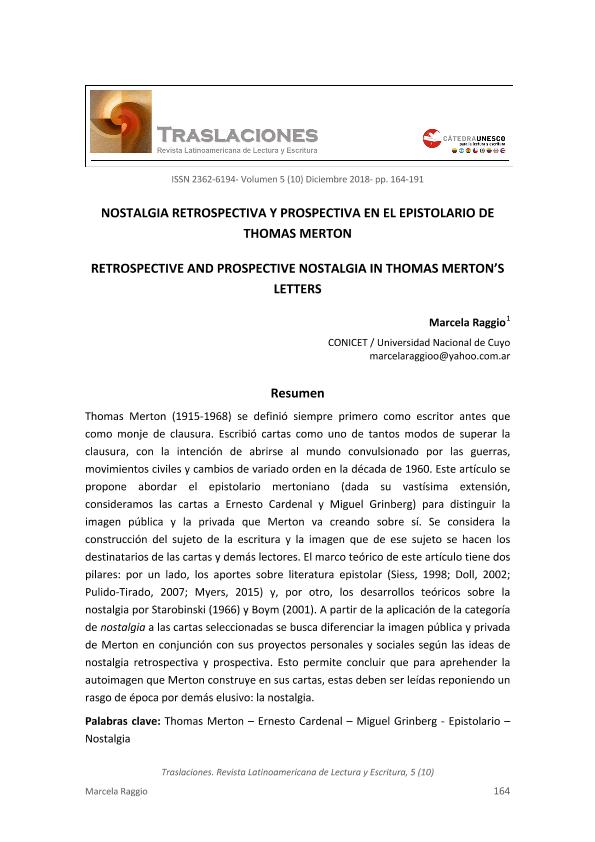Mostrar el registro sencillo del ítem
dc.contributor.author
Raggio, Marcela Maria

dc.date.available
2020-04-03T17:08:31Z
dc.date.issued
2018-10
dc.identifier.citation
Raggio, Marcela Maria; Nostalgia retrospectiva y prospectiva en el epistolario de Thomas Merton; Universidad Nacional de Cuyo. Cátedra Unesco de Lectura y Escritura Facultad de Educación; Traslaciones; 5; 10; 10-2018; 164-191
dc.identifier.issn
2362-6194
dc.identifier.uri
http://hdl.handle.net/11336/101858
dc.description.abstract
Thomas Merton (1915-1968) se definió siempre primero como escritor antes que como monje de clausura. Escribió cartas como uno de tantos modos de superar la clausura, con la intención de abrirse al mundo convulsionado por las guerras, movimientos civiles y cambios de variado orden en la década de 1960. Este artículo se propone abordar el epistolario mertoniano (dada su vastísima extensión, consideramos las cartas a Ernesto Cardenal y Miguel Grinberg) para distinguir la imagen pública y la privada que Merton va creando sobre sí. Se considera la construcción del sujeto de la escritura y la imagen que de ese sujeto se hacen los destinatarios de las cartas y demás lectores. El marco teórico de este artículo tiene dos pilares: por un lado, los aportes sobre literatura epistolar (Siess, 1998; Doll, 2002; Pulido-Tirado, 2007; Myers, 2015) y, por otro, los desarrollos teóricos sobre la nostalgia por Starobinski (1966) y Boym (2001). A partir de la aplicación de la categoría de nostalgia a las cartas seleccionadas se busca diferenciar la imagen pública y privada de Merton en conjunción con sus proyectos personales y sociales según las ideas de nostalgia retrospectiva y prospectiva. Esto permite concluir que para aprehender la autoimagen que Merton construye en sus cartas, estas deben ser leídas reponiendo un rasgo de época por demás elusivo: la nostalgia.
dc.description.abstract
Thomas Merton (1915-1968) always defined himself as a writer, more than a monk. He wrote letters profusely as a way of being in contact with the world outside the abbey, in an era shaken by the prospect of nuclear war, by civil, social and religious changes in several areas. This article approaches Merton’s letters to social and religious actors involved in the movements of the 1960s, in order to distinguish Merton’s private and public self-perception. The article considers the construction of the subject, and the image of that subject as perceived by the addressees and other readers. There are two pillars in our theoretical framework: on the one hand, contributions on epistolary writing (Siess 1998, Doll 2002, Pulido-Tirado 2007, Myers 2015), and on the other, the notion of nostalgia as developed by Starobinski (1966) and Boym (2001).By applying the category of nostalgia to the selected letters, the article aims at differentiating Merton’s private and public image in connection with his personal and social projects which can be understood as retrospectively and prospectively nostalgic. The conclusion proves that in order to understand Merton’s self-image in his letters, they should be read considering an elusive trait of the moment when they were written: namely, nostalgia.
dc.format
application/pdf
dc.language.iso
spa
dc.publisher
Universidad Nacional de Cuyo. Cátedra Unesco de Lectura y Escritura Facultad de Educación
dc.rights
info:eu-repo/semantics/openAccess
dc.rights.uri
https://creativecommons.org/licenses/by-nc-nd/2.5/ar/
dc.subject
THOMAS MERTON
dc.subject
ERNESTO CARDENAL
dc.subject
MIGUEL GRINBERG
dc.subject
EPISTOLARIO
dc.subject
NOSTALGIA
dc.subject.classification
Literaturas Específicas

dc.subject.classification
Lengua y Literatura

dc.subject.classification
HUMANIDADES

dc.title
Nostalgia retrospectiva y prospectiva en el epistolario de Thomas Merton
dc.title
Retrospective and prospective nostalgia in Thomas Merton’s letters
dc.type
info:eu-repo/semantics/article
dc.type
info:ar-repo/semantics/artículo
dc.type
info:eu-repo/semantics/publishedVersion
dc.date.updated
2020-03-20T13:14:29Z
dc.journal.volume
5
dc.journal.number
10
dc.journal.pagination
164-191
dc.journal.pais
Argentina

dc.journal.ciudad
Mendoza
dc.description.fil
Fil: Raggio, Marcela Maria. Universidad Nacional de Cuyo; Argentina. Consejo Nacional de Investigaciones Científicas y Técnicas. Centro Científico Tecnológico Conicet - Mendoza; Argentina
dc.journal.title
Traslaciones
dc.relation.alternativeid
info:eu-repo/semantics/altIdentifier/url/http://revistas.uncu.edu.ar/ojs/index.php/traslaciones/article/view/1633
Archivos asociados
